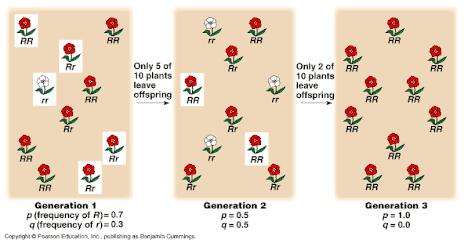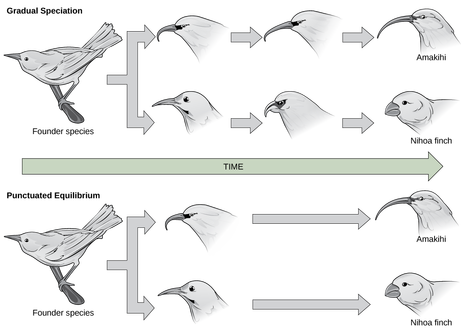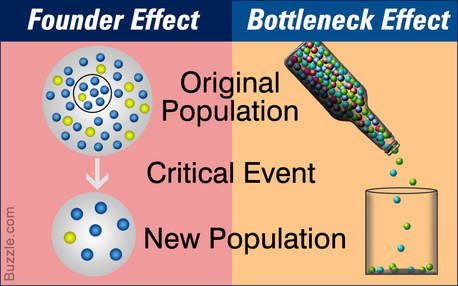Topic 10.3: Gene Pools and Speciation
 image from Study.com
image from Study.com
In the Gene Pools and Speciation unit we will learn some of the reasons why the genetics of a species can change over a long period of time. Charles Darwin's The Origin of Species went into great depth in this matter, and providing substance into the theory of evolution. The key thing to remember about evolution is that it favours more preferable genes in the gene pool, and over time, these preferable characteristics become more exclusive in the gene pool
This unit will last 2 days
This unit will last 2 days
Essential idea:
- Gene pools change over time.
Nature of science:
- Looking for patterns, trends and discrepancies—patterns of chromosome number in some genera can be explained by speciation due to polyploidy. (3.1)
- Define polyploidy.
- Outline causes of polyploidy.
- Explain how polyploidy can lead to speciation.
- Define polyploidy.
Understandings
10.3 U 1 A gene pool consists of all the genes and their different alleles, present in an interbreeding population. (Oxford Biology Course Companion pg 455)
- Define gene pool.
- Given data, calculate allele frequencies of genes in a gene pool.
- Given data, calculate genotype frequencies for genes in a gene pool.
A species is generally considered a group of potentially interbreeding populations that have a common gene pool and are reproductively isolated from other species. A gene pool is the set of all genes, including all the different alleles, in any interbreeding population, usually of a particular species
Allele frequency:
Allele frequency:
- the proportion of an allele within a population
- allele frequencies range from 0 to 1.0, or as a percentage
- evolution always involves a change in allele frequency in a population's gene pool, over a number of generations
- the sum total of alleles present in a sexually reproducing population.
10.3 U 2 Evolution requires that allele frequencies change with time in populations. (Oxford Biology Course Companion page 455)
- Define evolution.
- Outline five factors that can cause evolutionary change.
Evolution is the cumulative change in allele frequency or heritable characteristics in a population over time. The cumulative change can occur as a result of genetic mutations and selective pressures which favour certain heritable characteristics over other less favourable characteristics.
These populations have to be reproductively isolated, thus preventing gene flow between populations. If a population that has a certain allele or characteristic is quite small, random events such as disease or natural disasters can cause a drastic drop in this particular allele
These populations have to be reproductively isolated, thus preventing gene flow between populations. If a population that has a certain allele or characteristic is quite small, random events such as disease or natural disasters can cause a drastic drop in this particular allele
10.3 U 3 Reproductive isolation of populations can be temporal, behavioural or geographic. (Oxford Biology Course Companion page 458)
- Define speciation.
- Compare allopatric and sympatric speciation.
- Define reproductive isolation.
- Explain temporal, behavioral and geographic isolation as mechanisms of speciation.
- Describe an example of temporal, behavioral and geographic reproductive isolation.
PRE-ZYGOTIC BARRIERS (barriers that prevent mating or fertilisation):
POST-ZYGOTIC BARRIERS (barriers that prevent hybrid zygote turning into a strong adult):
- Temporal isolation - occurs when two species mate or flower at different times of the year.
- Behavioural isolation - occurs when two species respond to different specific courtship patterns.
- Geographic isolation - occurs when two populations of the same species or breeding group are separated by a physical barrier, such as a mountain or body of water.
- Ecological isolation - occurs when two species inhabit similar regions, but occupy different habitats.
- Mechanical isolation - occurs when genital differences prevent copulation (animals) or when flowers are pollinated by different animals (plants).
POST-ZYGOTIC BARRIERS (barriers that prevent hybrid zygote turning into a strong adult):
- Hybrid inviability - hybrids are produced but fail to develop to reproductive maturity.
- Hybrid infertility - hybrids fail to produce functional gametes.
- Hybrid breakdown - the F1 (first generation) hybrids are fertile but the F2 fail to develop or are infertile.
10.3 U 4 Speciation due to divergence of isolated populations can be gradual. (Oxford Biology Course Companion page 460)
- Define gradualism.
- Outline a limitation of the idea of evolution through gradualism.
- Identify gradualism from graphs of morphology changes over time.
Speciation can occur gradually over long periods of time, with several intermediate forms in between species leading to today’s current species. This can be seen by some of the more complete fossil records, like the whale. However, in some species, large gaps were evident for certain species in the fossil record. This could be explained by possible imperfections in the fossil record, or perhaps, these species have not been discovered yet.
Species descended from a common ancestor gradually diverge more and more in morphology i.e. become phenotypically different - adaptive radiation, through the slow but relentless effects of natural selection.
Species descended from a common ancestor gradually diverge more and more in morphology i.e. become phenotypically different - adaptive radiation, through the slow but relentless effects of natural selection.
10.3 U 5 Speciation can occur abruptly. (Oxford Biology Course Companion page 461)
- Define punctuated equilibrium.
- Outline a possible cause of rapid speciation events.
- Identify punctuated equilibrium from graphs of morphology changes over time.
Formation of new species which is reproductively and ecologically isolated from the parental species.as a result of a genetic mutation such as a sudden change in chromosome number or constitution. Genetic mutations such as non-disjunctions of an entire set of chromosomes can cause a doubling of chromosomes (polyploidy) resulting in a different species. Also interbreeding of two genetically different organisms can produce hybrids which are generally infertile
Application
10.3 A 1 Identifying examples of directional, stabilizing and disruptive selection (Oxford Biology Course Companion page 252)
- Define stabilizing, disruptive and directional selection.
- Use graphs to illustrate or identify stabilizing, disruptive and directional selection.
Directional Selection:
Stabilizing Selection:
Disruptive Selection:
- Selection that removes individuals from one end of a phenotypic distribution and thus causes a shift in the distribution towards the other end. This occurs when natural selection favours one extreme end of the continuous variation of phenotypes. Over time, the favoured extreme will become more common and the other extreme will be less common or lost. For example, dark mice are favoured because they live in an area that favours that phenotype.
Stabilizing Selection:
- A type of selection that removes individuals from both ends of a phenotypic distribution, thus maintaining the same distribution mean. This occurs when natural selection favours the intermediate phenotypes. Over time, the intermediate states become more common and each extreme variation will become less common or lost. Same mouse example where medium coloured fur is favoured over dark or light fur colour.
Disruptive Selection:
- A type of selection that removes individuals from the center of a phenotypic distribution and thus causes the distribution to become bimodal. This occurs when natural selection favours both ends of the phenotypic variation. Over time, the two extreme variations will become more common and the intermediate states will be less common or lost. Disruptive selection can lead to two new species. Light coloured and dark coloured mice might live in an environment with patches of light and dark vegetation making it hard for predators to spot those colours, while the middle coloured mouse doesn’t blend into either background.
10.3 A 2 Speciation in the genus Allium by polyploidy. (Oxford Biology Course Companion page 462)
- List example species in the genus Allium (by common name).
- Outline how polyploidy has led to many species of Allium.
The genus Allium comprises monocot flowering plants and includes the onion, garlic, chives, scallion, shallot, and the leek. In many of these species of plants, chromosome doubling has occurred naturally and through hybridization or selective breeding to create a large number of different phenotypes. This results in a number of reproductively isolated but similar populations.
Polyploidy is a condition in which an organism has more than two complete sets of chromosomes in all somatic cells i.e. > diploid. It is far more common in plant species as they lack separate sexes and are capable of asexual reproduction (self-pollination). It may occur as a result of the failure of a meiotic cell to undergo cytokinesis (so chromosome replication occurs minus cell division). Consequently, gametes are diploid (2n) and resulting offspring are tetraploid (4n). Because tetraploid offspring can no longer mate with diploid organisms (triploid offspring tend to be infertile), speciation has occurred.
Polyploidy is a condition in which an organism has more than two complete sets of chromosomes in all somatic cells i.e. > diploid. It is far more common in plant species as they lack separate sexes and are capable of asexual reproduction (self-pollination). It may occur as a result of the failure of a meiotic cell to undergo cytokinesis (so chromosome replication occurs minus cell division). Consequently, gametes are diploid (2n) and resulting offspring are tetraploid (4n). Because tetraploid offspring can no longer mate with diploid organisms (triploid offspring tend to be infertile), speciation has occurred.
Skills
10.3 S 1 Comparison of allele frequencies of geographically isolated populations.(Oxford Biology Course Companion page 459)
- Compare allele frequencies of two populations.
- Describe how variations in the allele frequencies of a gene may be evidence of speciation.
Genetic drift is the change in the composition of a gene pool as a result of chance or random eventsIt will occur faster and be more significant in smaller populations, where chance events have a bigger impact on the gene pool. Larger populations will be less affected by random events and maintain more stable allele frequencies with low genetic drift Allele frequencies will change significantly when a large population is reduced to a small population
Key Terms
|
allele frequency
disruptive selection sympatric speciation hybrid |
evolution
genetic drift isolation gradualism |
natural selection
speciation temporal isolation punctuated |
stabilising selection
allopatric speciation behavioural isolation hybridisation |
directional selection
geographic speciation polyploidy |
PowerPoint and Study Guide on Topic 10.3 by Chris Payne
Your browser does not support viewing this document. Click here to download the document.
Your browser does not support viewing this document. Click here to download the document.
Correct use of terminology is a key skill in Biology. It is essential to use key terms correctly when communicating your understanding, particularly in assessments. Use the quizlet flashcards or other tools such as learn, scatter, space race, speller and test to help you master the vocabulary.
Useful Links
Sickle Cell Anemia Presentation
Mechanisms of Speciation Animation
Founder Effects & Speciation Animation
Salamander Speciation
Sympatric Speciation
Allopatric Speciation
Hardy-Weinberg Practice Problems
Hardy-Weinberg Practice Problems 2
In the News
TOK
- Punctuated equilibrium was long considered an alternative theory of evolution and a challenge to the long established paradigm of Darwinian gradualism. How do paradigm shifts proceed in science and what factors are involved in their success?
Video Clips
Anole lizards of the Caribbean islands are members of about 150 closely related species, most of which evolved within the past 50 million years from a single colonizing species. See the evolutionary process firsthand with this compelling case study in evolution.
There is a dizzying diversity of species on our planet. From genetic evidence we know that all of those species evolved from a single ancient ancestor. But how does one species split in to many? Through the evolutionary process of speciation — which begins when populations become isolated by changes in geography or by shifts in behavior so that they no longer interbreed. This video illustrates the speciation process in birds to help you understand the basis of earth's biodiversity.
Hank explains speciation - the evolutionary process by which new biological species arise - in terms of finches, ligers, mules, and dogs
Paul Andersen explains how reproductive isolation can eventually lead to speciation. Three main barriers to gene flow are included: geographic, pre-zygotic and post-zygotic. Both allopatric and sympatric speciation are discussed. A brief discussing of polyploidy and punctuated equilibrium are also included.
Explore speciation with The Amoeba Sisters. This video discusses sympatric and allopatric speciation and covers several types of isolation types including behavioral, temporal, and habitat isolations.
Process of Evolution | Gradualism vs Punctuated Equilibrium vs Catastrophism
Explore Research at the University of Florida: Pam and Doug Soltis, distinguished professors with the Florida Museum of Natural History, discuss the importance of Tragopogon, a flowering plant in the sunflower family, and its role in helping understand more about the polyploids. Polyploids are organisms with more than two sets of chromosomes and represent a large number of agricultural crops. The Soltises are analyzing Tragopogon to gain a better understanding of the process of genome change and evolution in polyploidy organisms.
In this video Paul Andersen explains the elements in the Hardy-Weinberg equation; including the allele frequency and phenotype frequency. He begins with a brief explanation of phenotypes and genotypes. A sample problem is worked out and another problem is included.
Paul Andersen shows you how to solve simple Hardy-Weinberg problems. He starts with a brief description of a gene pool and shows you how the formula is derived. He then shows you how to solve a couple of sample problems.








